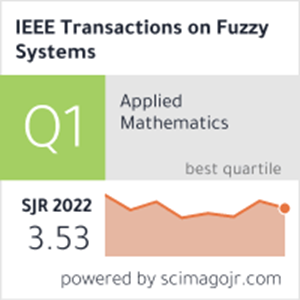高维分类问题区间型-2 Takagi-Sugeno-Kang模糊系统的辨识与收敛性分析
IF 10.7
1区 计算机科学
Q1 COMPUTER SCIENCE, ARTIFICIAL INTELLIGENCE
引用次数: 0
摘要
针对多分类问题,提出了一种新的去模糊化算法,可以有效地提高区间2型模糊系统的准确率、稳定性和计算效率。此外,为了使模糊系统能够处理高维数据,本文还设计了一种基于门函数和Group $L_{0}$正则化的协同特征选择策略,有效地解决了模糊系统在处理高维问题时面临的挑战。该策略允许系统选择相关的特征,减轻了维数的困扰。最后,采用均方根传播算法对区间型2型Takagi-Sugeno-Kang模糊系统的前、后参数进行同步优化,并对算法进行收敛性分析,以保证所提方法的有效性和可靠性。为了验证所提算法的性能,我们在高维数据集上进行了仿真实验。结果证明了该方法在处理多分类任务和处理复杂高维数据方面的优越性。本文章由计算机程序翻译,如有差异,请以英文原文为准。
Identification and Convergence Analysis of Interval Type-2 Takagi–Sugeno–Kang Fuzzy Systems for High-Dimensional Classification Problems
In this article, a new defuzzification algorithm is proposed for multiclassification problems, which can effectively improve the accuracy, stability, and computational efficiency of interval type-2 fuzzy systems. In addition, in order to enable the fuzzy system to handle high-dimensional data, this article also designs a collaborative feature selection strategy based on gate function and Group $L_{0}$
求助全文
通过发布文献求助,成功后即可免费获取论文全文。
去求助
来源期刊

IEEE Transactions on Fuzzy Systems
工程技术-工程:电子与电气
CiteScore
20.50
自引率
13.40%
发文量
517
审稿时长
3.0 months
期刊介绍:
The IEEE Transactions on Fuzzy Systems is a scholarly journal that focuses on the theory, design, and application of fuzzy systems. It aims to publish high-quality technical papers that contribute significant technical knowledge and exploratory developments in the field of fuzzy systems. The journal particularly emphasizes engineering systems and scientific applications. In addition to research articles, the Transactions also includes a letters section featuring current information, comments, and rebuttals related to published papers.
 求助内容:
求助内容: 应助结果提醒方式:
应助结果提醒方式:


